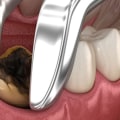Tooth extraction is a common procedure, but it can lead to infection if not done properly. Infection after tooth extraction can be painful and cause a lot of discomfort. It is important to be aware of the signs of infection after tooth extraction so that you can seek medical attention as soon as possible. The most common sign of infection after tooth extraction is an unpleasant or foul smell coming from the mouth.
You may also see secretions in or around the area, and any gum swelling that doesn't start to go away after 24 hours could be a sign of infection. Sharp, long-lasting pain after tooth extraction is another sign of infection. This complication occurs when bacteria move to the removed area. How long it will take for the infected tooth after it is extracted depends on the severity of the infection, but in most cases, patients are completely cured within one to two weeks.
If left untreated, bacteria can enter the bloodstream and cause additional problems. Once the dentist removes the affected tooth, the bacteria are still alive in the mouth and can be found in people with poor dental hygiene. As you know, tooth extraction infection causes a lot of pain. Therefore, it requires immediate action.
The best way to avoid infection after the procedure is to follow all of your dentist's advice. This includes keeping the site clean and avoiding smoking immediately after endodontics. It's common to have some swelling after the procedure, but if you notice that it gets worse over time, it means that something is wrong. Pus from the extracted site is another sign to watch out for; if you see yellow or white pus in the tooth socket, call your dentist immediately. Pain is the main symptom of infection after tooth extraction and should decrease after a few days of the procedure.
However, if you notice that your pain increases over time, it could be a cause for concern. Fever is another indicator of infection after a tooth is extracted; if you experience this symptom, call your dentist right away. Sometimes, the dentist recommends a pain reliever or other topical pain relievers to relieve pain in the infected cavity after the procedure. If the pain becomes uncontrollable, they may offer prescription pain medications. There are some symptoms that are severe enough to cause an immediate visit to the emergency room; fever and jaw swelling together, with or without difficulty breathing, mean that you may be experiencing life-threatening sepsis (or that you are about to experience it).
A bone infection after tooth extraction is a dangerous ailment and can lead to sepsis if left untreated. Sepsis is an infection caused by anything (virus, bacteria, fungi) that enters the bloodstream and can affect the flow to vital organs of the system. As sepsis worsens, it can affect breathing, oxygen levels throughout the body, cause dehydration, and even cause mental and emotional distress. If you're concerned about signs of infection after oral surgery, call your dentist to schedule an appointment. If you go to them before extraction and have swelling of your face, swelling of the gums, pain in your teeth when applying light pressure, or bleeding around the extraction site, then you may already have an infection.
If this is true, they will prescribe antibiotics for you to use after treatment. Patients who develop an ear infection as a result of a tooth extraction may also experience ear pain and dizziness. As long as you take care of the extraction site and do what your dentist says, you shouldn't have any more problems with it or with any infections. In very rare cases, a deep infection of the neck in cervical vertebrae can occur after tooth extraction. To avoid this complication and other infections related to tooth extractions, follow all instructions given by your dentist regarding care after tooth extraction and practice good oral hygiene.






